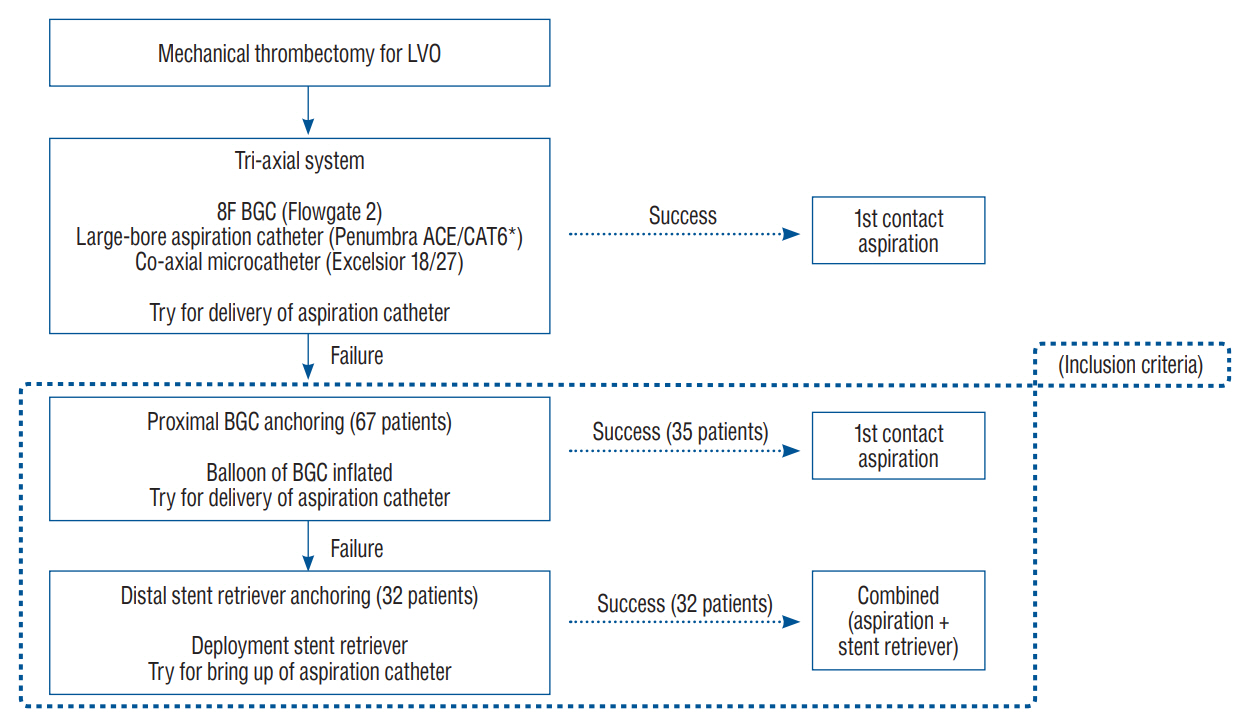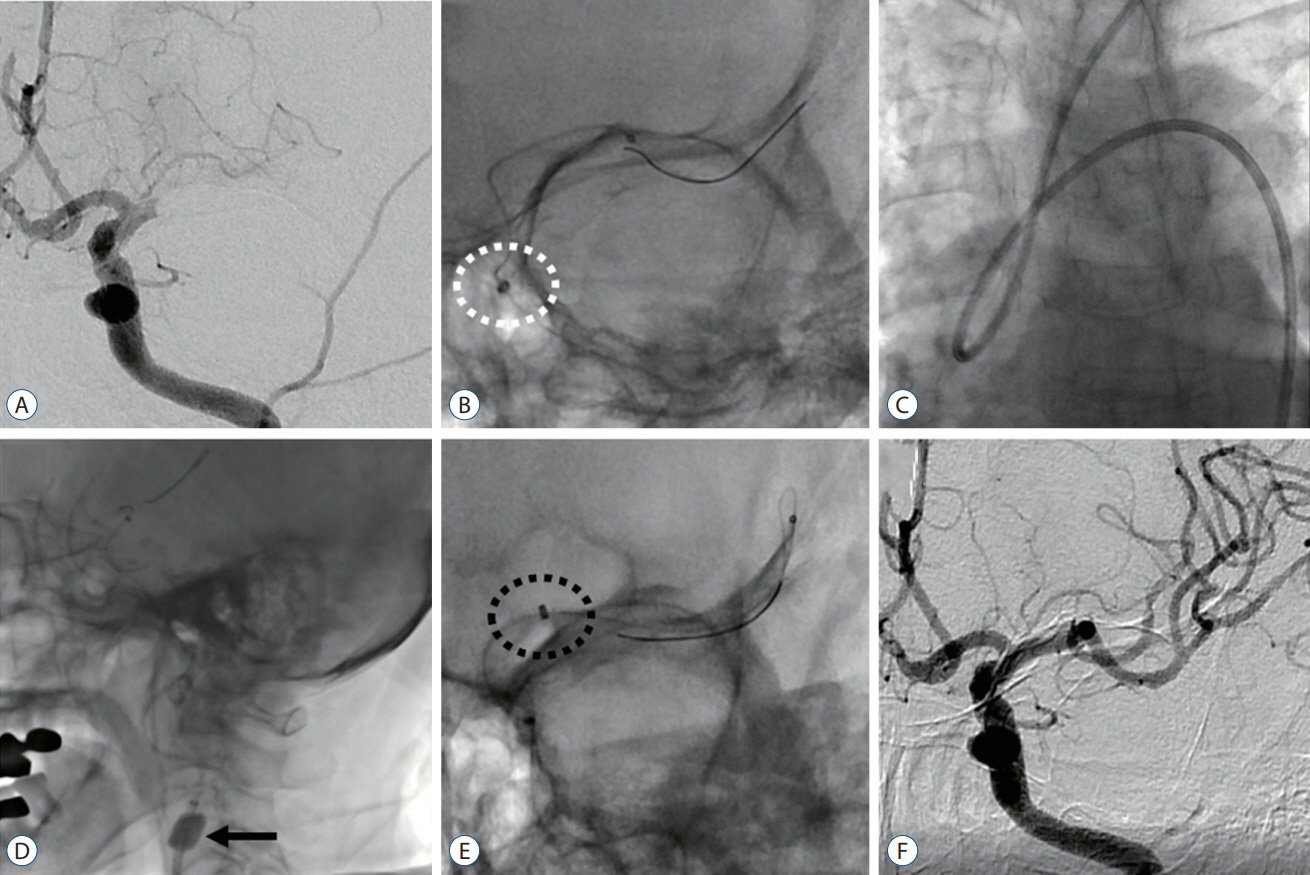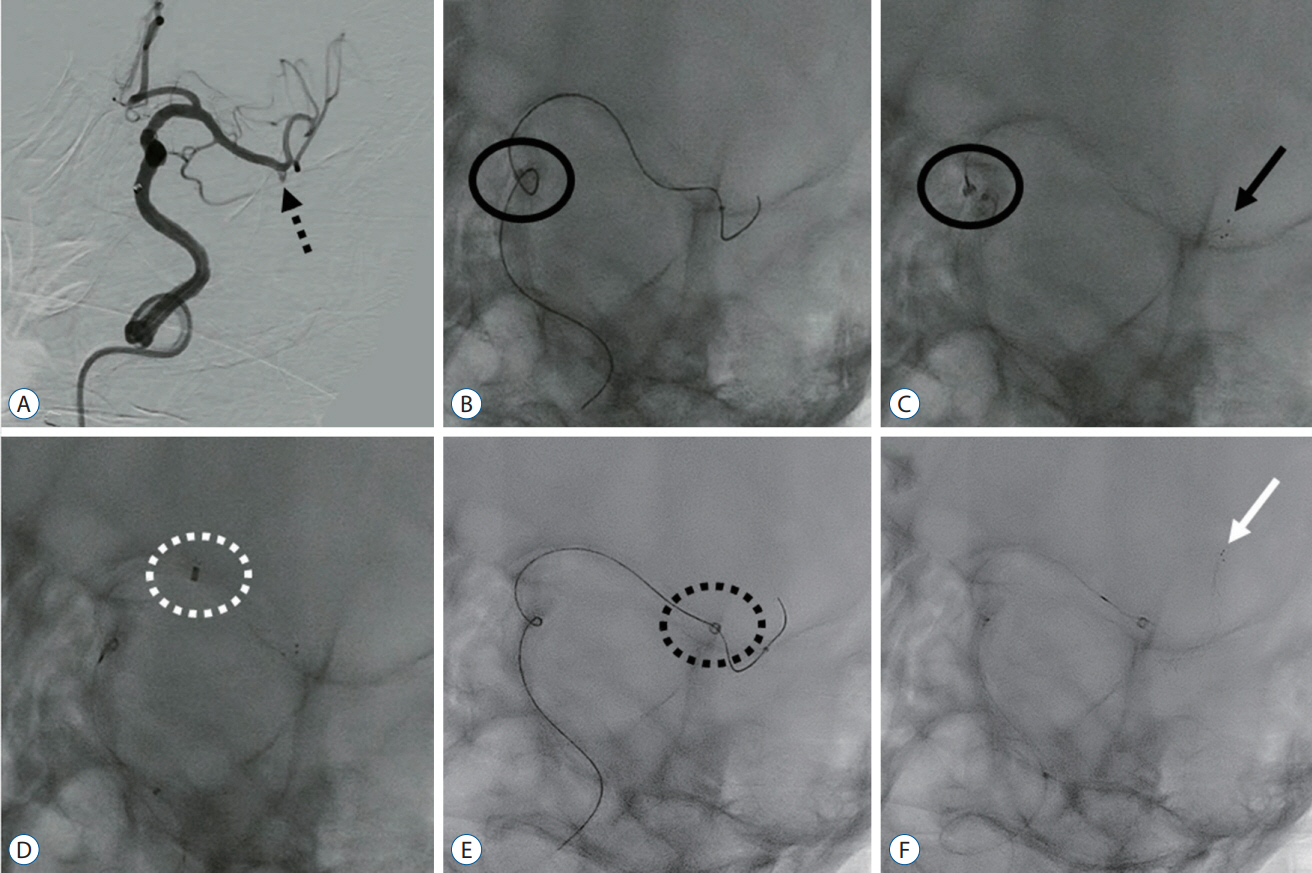J Korean Neurosurg Soc.
2022 Jul;65(4):514-522. 10.3340/jkns.2021.0158.
Effectiveness of Anchoring with Balloon Guide Catheter and Stent Retriever in Difficult Mechanical Thrombectomy for Large Vessel Occlusion
- Affiliations
-
- 1Department of Neurosurgery, Soonchunhyang University Bucheon Hospital, Bucheon, Korea
- 2Department of Neurosurgery, St. Vincent’s Hospital, College of Medicine, The Catholic University of Korea, Seoul, Korea
- KMID: 2531620
- DOI: http://doi.org/10.3340/jkns.2021.0158
Abstract
Objective
: A distal navigation of a large bore aspiration catheter during mechanical thrombectomy (MT) is important. However, delivering a large bore aspiration catheter is difficult to a tortuous or atherosclerotic artery. We report the experience of anchoring with balloon guide catheter (BGC) and stent retriever to facilitate the passage of an aspiration catheter in MT.
Methods
: When navigating an aspiration catheter failed with a conventional co-axial microcatheter delivery, an anchoring technique was used. Two types of anchoring technique were applied to facilitate distal navigation of a large bore aspiration catheter during MT. First, a passage of aspiration catheter was attempted with a proximal BGC anchoring technique. If this technique also failed, another anchoring technique with distal stent retriever was tried. Consecutive patients who underwent MT with an anchoring technique were identified. Details of procedure, radiologic outcomes, and safety variables were evaluated.
Results
: A total of 67 patients underwent MT with an anchoring technique. Initial trial of aspiration catheter passage with proximal BGC anchoring technique was successful for 35 patients (52.2%) and the second trial with distal stent retriever anchoring was successful for 32 patients (47.8%). Overall, navigation of a large bore aspiration catheter was successful for all patients (100%) without any procedure related complications.
Conclusion
: Our study showed the usefulness of anchoring technique with proximal BGC and distal stent retriever during MT, especially in those with an unfavorable anatomical structure. This technique could be an alternative option for delivering an of aspiration catheter to a distal location
Keyword
Figure
Reference
-
References
1. Amarenco P, Bogousslavsky J, Caplan LR, Donnan GA, Hennerici MG. Classification of stroke subtypes. Cerebrovasc Dis. 27:493–501. 2009.
Article2. Crowley RW, Abla AA, Ducruet AF, McDougall CG, Albuquerque FC. Novel application of a balloon-anchoring technique for the realignment of a prolapsed pipeline embolization device: a technical report. J Neurointerv Surg. 6:439–444. 2014.
Article3. Fargen KM, Velat GJ, Lawson MF, Hoh BL, Mocco J. The stent anchor technique for distal access through a large or giant aneurysm. J Neurointerv Surg. 5:e24. 2013.
Article4. Goto S, Ohshima T, Ishikawa K, Yamamoto T, Shimato S, Nishizawa T, et al. A stent-retrieving into an aspiration catheter with proximal balloon (ASAP) technique: a technique of mechanical thrombectomy. World Neurosurg. 109:e468–e475. 2018.
Article5. Goyal M, Menon BK, Van Zwam WH, Dippel DW, Mitchell PJ, Demchuk AM, et al. Endovascular thrombectomy after large-vessel ischaemic stroke: a meta-analysis of individual patient data from five randomised trials. Lancet. 23:387. 2016.
Article6. Hacke W, Kaste M, Bluhmki E, Brozman M, Dávalos A, Guidetti D, et al. Thrombolysis with alteplase 3 to 4.5 hours after acute ischemic stroke. N Engl J Med. 359:1317–1329. 2008.
Article7. Hopf-Jensen S, Preiß M, Marques L, Lehrke S, Schattschneider J, Stolze H, et al. Impact and effectiveness of dual aspiration technique in stent-assisted mechanical thrombectomy: recent improvements in acute stroke management. Cardiovasc Intervent Radiol. 39:1620–1628. 2016.
Article8. Kang DH, Park J. Endovascular stroke therapy focused on stent retriever thrombectomy and direct clot aspiration: historical review and modern application. J Korean Neurosurg Soc. 60:335–347. 2017.
Article9. Kim SH, Lee H, Kim SB, Kim ST, Baek JW, Heo YJ, et al. Hybrid mechanical thrombectomy for acute ischemic stroke using an intermediate aspiration catheter and Trevo stent simultaneously. J Clin Neurosci. 76:9–14. 2020.
Article10. Lapergue B, Blanc R, Guedin P, Decroix JP, Labreuche J, Preda C, et al. A direct aspiration, first pass technique (ADAPT) versus stent retrievers for acute stroke therapy: an observational comparative study. AJNR Am J Neuroradiol. 37:1860–1865. 2016.
Article11. Lee DH, Sung JH, Kim SU, Yi HJ, Hong JT, Lee SW. Effective use of balloon guide catheters in reducing incidence of mechanical thrombectomy related distal embolization. Acta Neurochir (Wien). 159:1671–1677. 2017.
Article12. Li ZS, Zhou TF, Li Q, Guan M, Liu H, Zhu LF, et al. Endovascular management of intracranial atherosclerosis-related large vessel occlusion with the a direct aspiration first-pass thrombectomy compared with solumbra technique. Front Neurol. 12:643633. 2021.
Article13. Lin CM, Wu YM, Chang CH, Chen CC, Wang AY. The ANTRACK technique: employing a compliant balloon or stent retriever to advance a large-bore catheter to an occlusion during thrombectomy procedures in acute stroke patients. Oper Neurosurg (Hagerstown). 16:692–699. 2019.
Article14. Mascitelli JR, Pain M, Zarzour HK, Baxter P, Ghatan S, Mocco J. Sinus thrombectomy for purulent cerebral venous sinus thrombosis utilizing a novel combination of the trevo stent retriever and the penumbra ACE aspiration catheter: the stent anchor with mobile aspiration technique. J Neurointerv Surg. 8:e24. 2016.
Article15. Maus V, Behme D, Kabbasch C, Borggrefe J, Tsogkas I, Nikoubashman O, et al. Maximizing first-pass complete reperfusion with SAVE. Clin Neuroradiol. 28:327–338. 2018.
Article16. Munich SA, Vakharia K, Levy EI. Overview of mechanical thrombectomy techniques. Neurosurgery. 85(Suppl 1):S60–S67. 2019.
Article17. Nguyen TN, Malisch T, Castonguay AC, Gupta R, Sun CH, Martin CO, et al. Balloon guide catheter improves revascularization and clinical outcomes with the solitaire device: analysis of the north american solitaire acute stroke registry. Stroke. 45:141–145. 2014.18. Nikoubashman O, Nikoubashman A, Büsen M, Wiesmann M. Necessary catheter diameters for mechanical thrombectomy with ADAPT. AJNR Am J Neuroradiol. 38:2277–2281. 2017.
Article19. Oh JS, Yoon SM, Shim JJ, Doh JW, Bae HG, Lee KS. Efficacy of balloon-guiding catheter for mechanical thrombectomy in patients with anterior circulation ischemic stroke. J Korean Neurosurg Soc. 60:155–164. 2017.
Article20. Ohshima T, Miyachi S. A novel technique for mitigation of the ledge effect caused by the use of a large-lumen catheter during neurointervention: beanstalk method. Asian J Neurosurg. 15:753–755. 2020.
Article21. Romano DG, Frauenfelder G, Casseri T, Piano M, Vinci S, Comai A, et al. Efficacy of ADAPT with large-bore reperfusion catheter in anterior circulation acute ischemic stroke: a multicentric italian experience. Radiol Med. 125:57–65. 2020.
Article22. Sharashidze V, Nogueira RG, Al-Bayati AR, Grossberg JA, Haussen DC. Balloon anchoring technique for thrombectomy in hostile craniocervical arterial anatomy. J Neurointerv Surg. 12:763–767. 2020.
Article23. Singh J, Wolfe SQ, Janjua RM, Hedayat H, Burnette C. Anchor technique: use of stent retrievers as an anchor to advance thrombectomy catheters in internal carotid artery occlusions. Interv Neuroradiol. 21:707–709. 2015.
Article24. Snyder KV, Natarajan SK, Hauck EF, Mocco J, Siddiqui AH, Hopkins LN, et al. The balloon anchor technique: a novel technique for distal access through a giant aneurysm. J Neurointerv Surg. 2:363–367. 2010.
Article25. Takahira K, Kataoka T, Ogino T, Endo H, Nakamura H. Efficacy of a coaxial system with a compliant balloon catheter for navigation of the penumbra reperfusion catheter in tortuous arteries: technique and case experience. J Neurosurg. 126:1334–1338. 2017.
Article26. Turk AS, Frei D, Fiorella D, Mocco J, Baxter B, Siddiqui A, et al. ADAPT FAST study: a direct aspiration first pass technique for acute stroke thrombectomy. J Neurointerv Surg. 6:260–264. 2014.
Article27. Turk AS, Frei D, Fiorella D, Mocco J, Baxter B, Siddiqui A, et al. ADAPT FAST study: a direct aspiration first pass technique for acute stroke thrombectomy. J Neurointerv Surg. 10(Suppl 1):i4–i7. 2018.
Article28. Uysal E, Caliskan C, Caymaz I, Orken DN, Basak M. Stenting of vertebral artery origin with the buddy wire technique in tortuous subclavian artery. A case report. Interv Neuroradiol. 16:175–178. 2010.
Article29. Vakharia K, Munich SA, Tso MK, Waqas M, Levy EI. Stent anchor technique to reduce microcatheter loop for stent-assisted coiling of anterior communicating artery aneurysm. Neurosurg Focus. 46(Suppl 1):V8. 2019.
Article30. Woo HG, Sunwoo L, Jung C, Kim BJ, Han MK, Bae HJ, et al. Feasibility of permanent stenting with solitaire FR as a rescue treatment for the reperfusion of acute intracranial artery occlusion. AJNR Am J Neuroradiol. 39:331–336. 2018.
Article31. Yi HJ, Lee DH, Sung JH. Clinical usefulness of waiting after stent deployment in mechanical thrombectomy: effect of the clot integration. World Neurosurg. 119:e87–e93. 2018.
Article32. Yi HJ, Sung JH, Lee DH. Preliminary experience of neuroform atlas stenting as a rescue treatment after failure of mechanical thrombectomy caused by residual intracranial atherosclerotic stenosis. J Korean Neurosurg Soc. 64:198–206. 2021.
Article33. Yi HJ, Sung JH, Lee DH, Song SY. Effectiveness and technical considerations of solitaire platinum 4×40 mm stent retriever in mechanical thrombectomy with solumbra technique. J Korean Neurosurg Soc. 64:30–38. 2021.
Article34. Yi HJ, Sung JH, Lee MH, Lee DH. Experience of the new flowgate2 device as a balloon guide catheter for ischemic stroke intervention. World Neurosurg. 126:e736–e742. 2019.
Article35. Yoo AJ, Frei D, Tateshima S, Turk AS, Hui FK, Brook AL, et al. The penumbra stroke system: a technical review. J Neurointerv Surg. 4:199–205. 2012.
Article
- Full Text Links
- Actions
-
Cited
- CITED
-
- Close
- Share
- Similar articles
-
- Suction thrombectomy of distal medium vessel occlusion using microcatheter during mechanical thrombectomy for acute ischemic stroke: A case series
- Mechanical Thrombectomy for Large Vessel Occlusion via the Transbrachial Approach: Case Series
- Successful Mechanical Thrombectomy in a 2-Year-Old Male Through a 4-French Guide Catheter
- Inadvertent Detachment of Stent Retrievers: Report of 2 Cases
- Salvage treatment with stenting and temporary balloon occlusion for subarachnoid hemorrhage after stent retrieval following acute proximal M3 occlusion treatment




